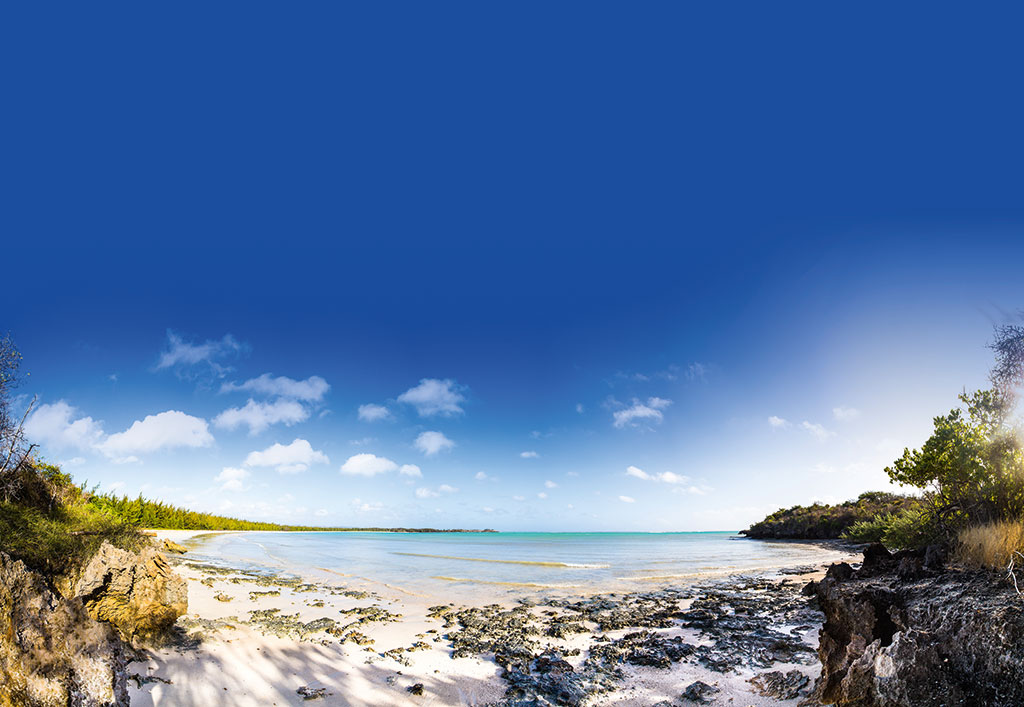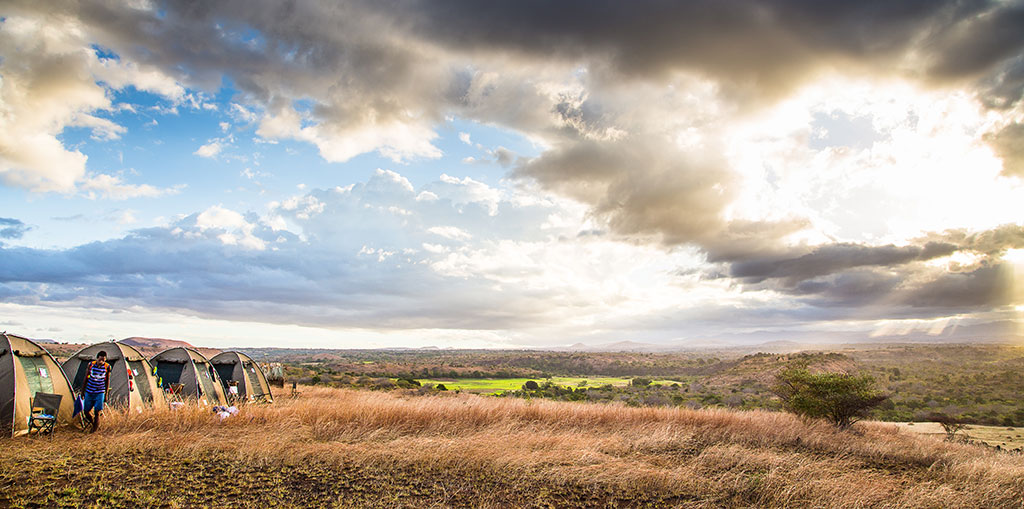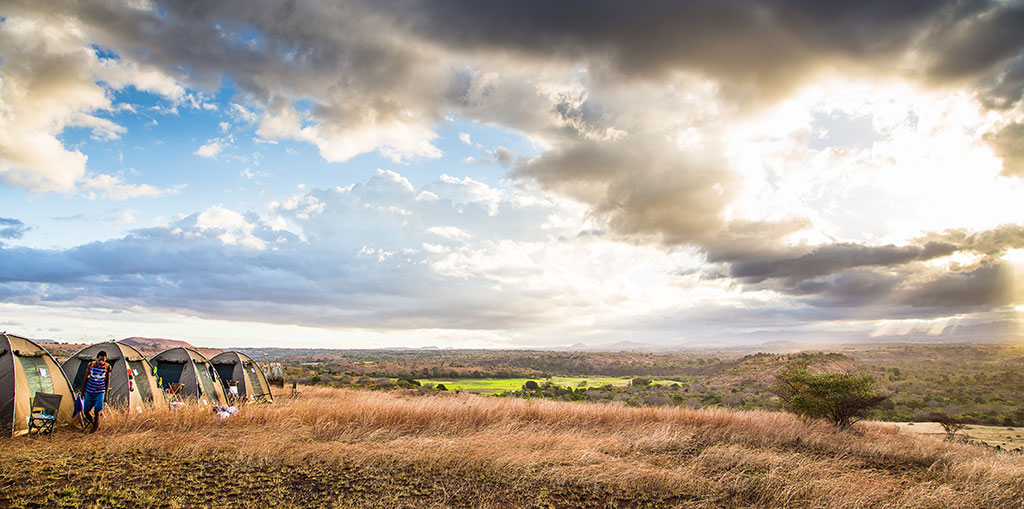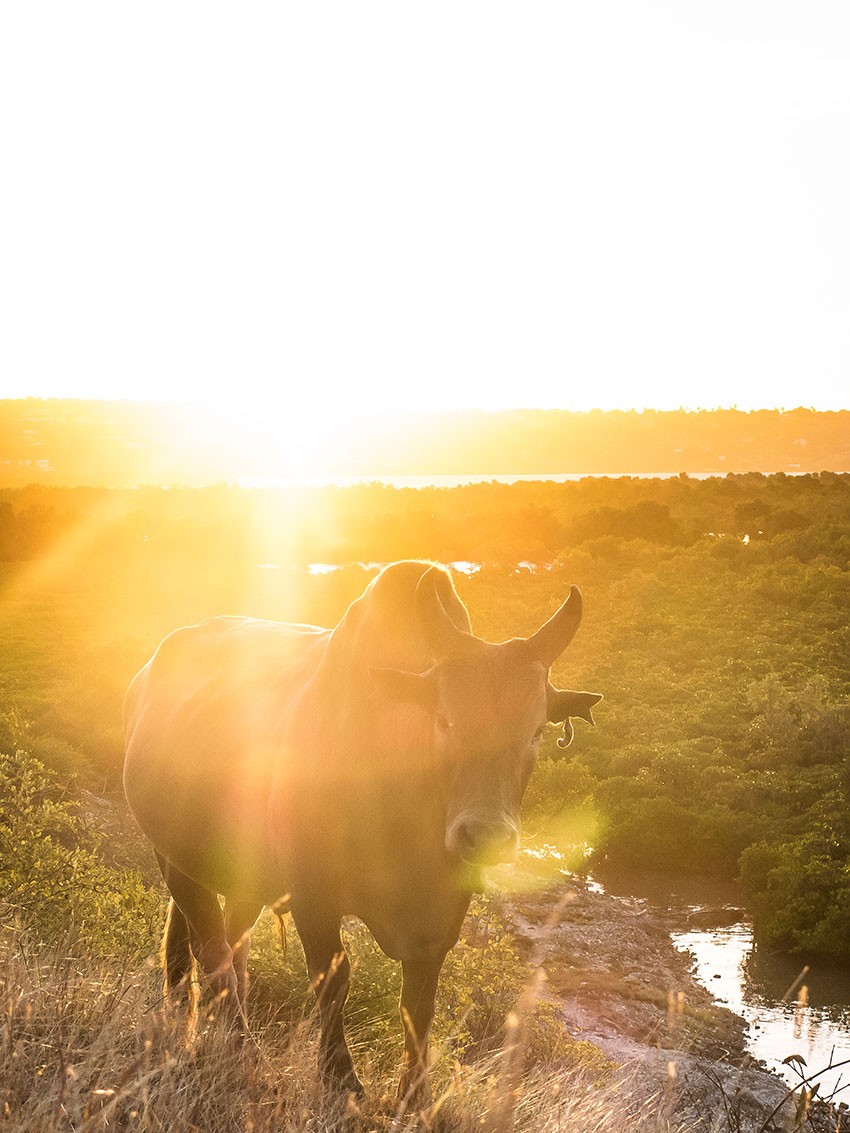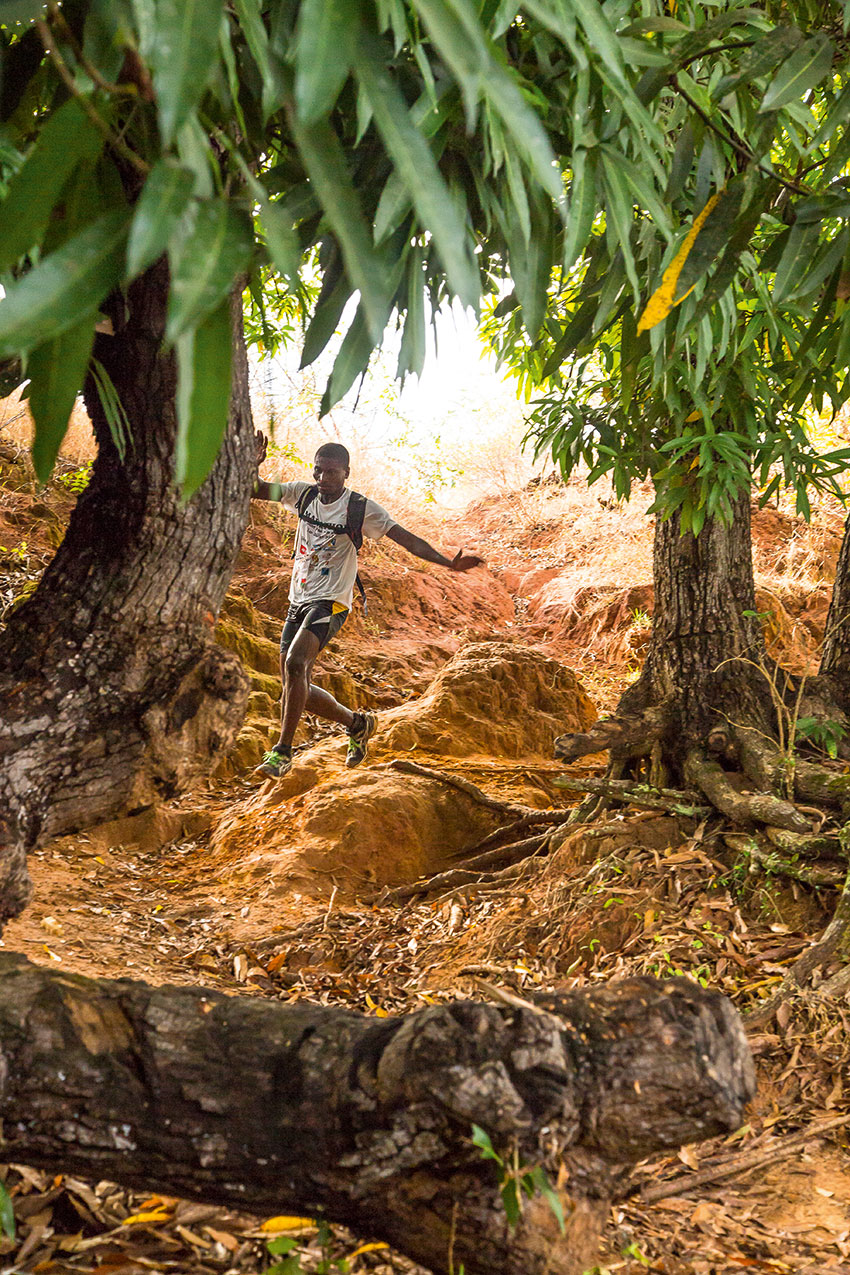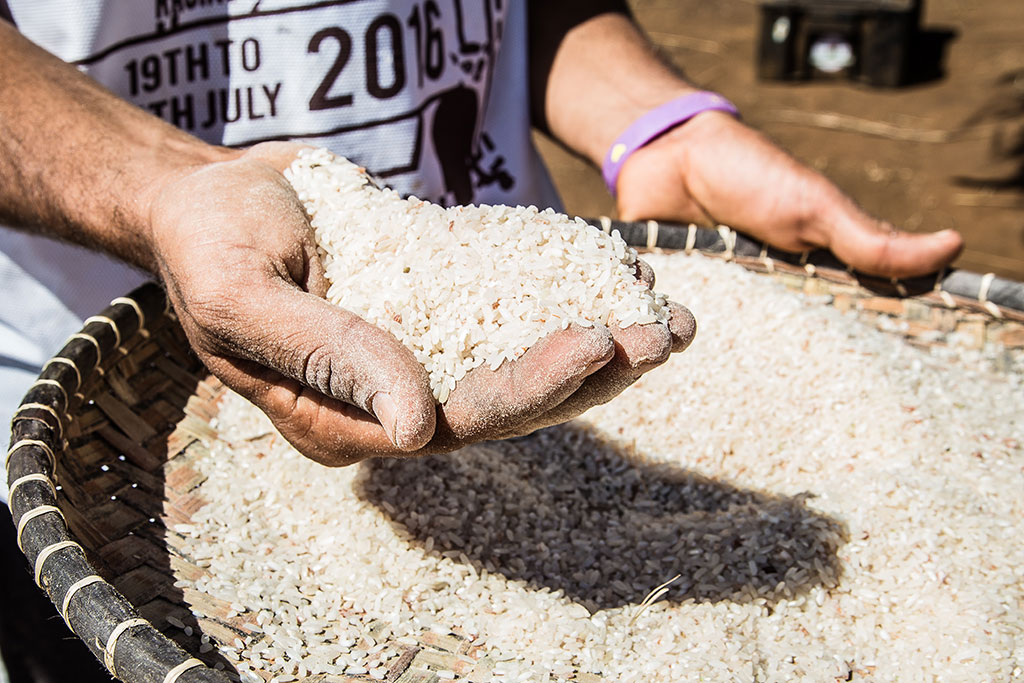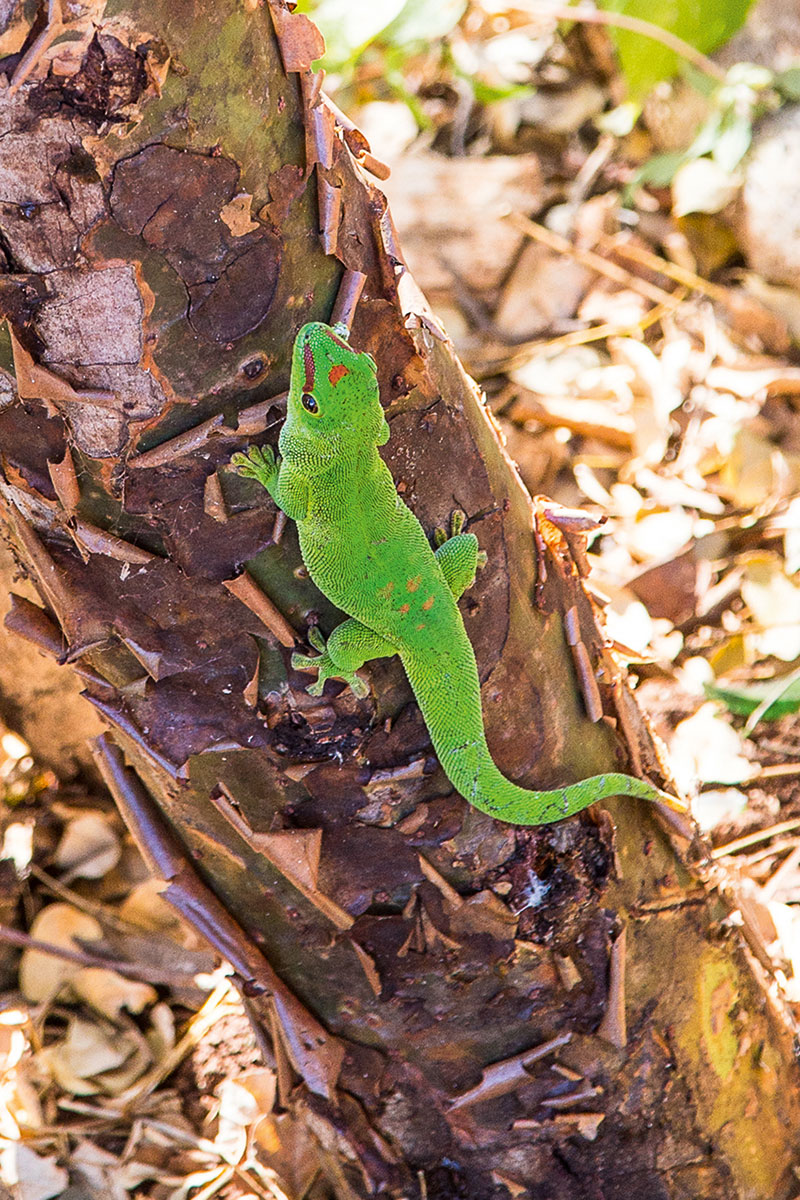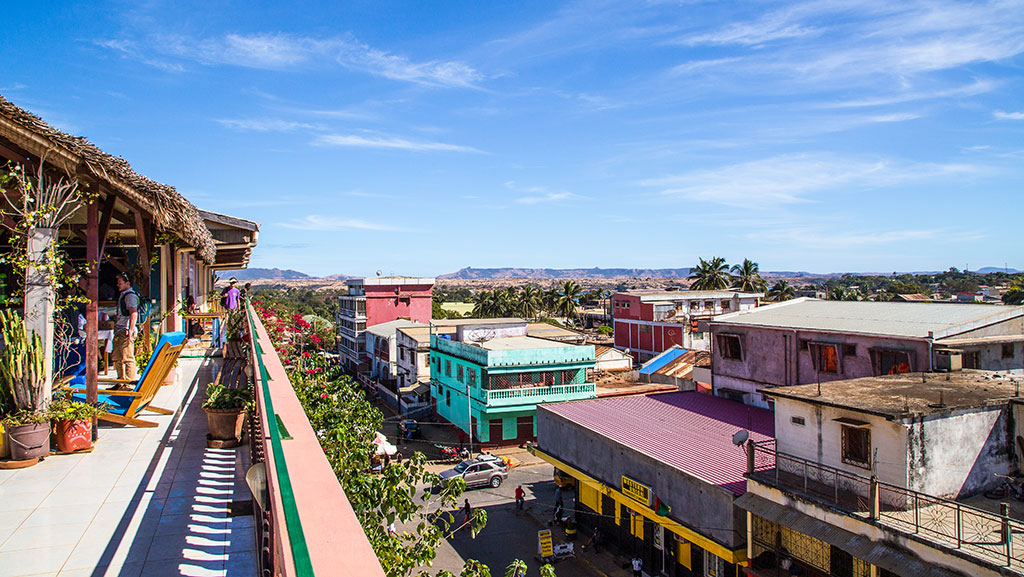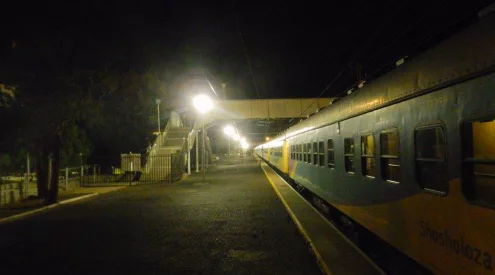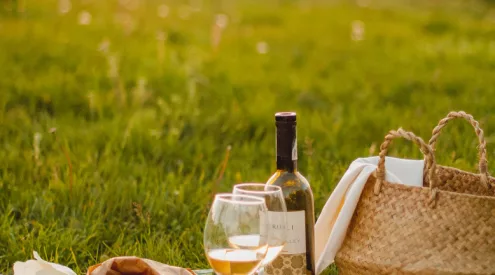In a remote region of northern Madagascar, Tyson Jopson joined 23 runners from around the world on a one-of-a-kind race that merges the toughness of trail running with the rewards of travel.
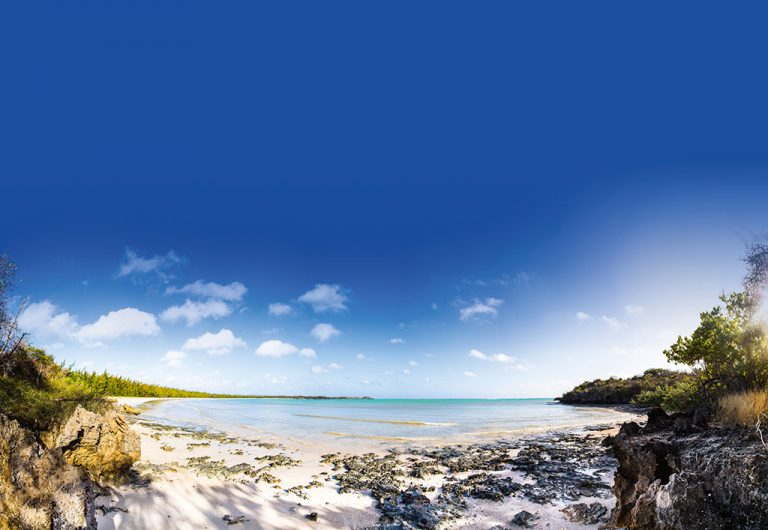
Earlier this year I learned of the total distance covered in the world’s longest official ultra-marathon. It’s just shy of 5 000 kilometres. That is not the most staggering thing about it. The entire course spans a city block in Queens, New York. To complete it, athletes lap the block 5 649 times. The record holder is a 44-year-old Finnish courier named Ashprihanal Aalto who, in 2015, completed the ‘neighbourhood dash’ in 40 days and nine hours.
I’m suspicious of people like this. Finland might not be the most riveting place in the world to live but why would anyone from there (or anywhere else) want to fly to New York, pay for a hotel, catch the subway at least twice and pay an extortionate amount of money for a disappointing cream cheese bagel at least once, to go pound the same bit of pavement every day? It’s an awful lot of money to go somewhere new and then not explore it. Or at least explore only the bits between 164th and 168th Street.
Perhaps it was with that knowledge, tucked away in a reservoir of pub-quiz information along with the density of Saturn (687kg/m3), that I leapt at the chance to cover a foot race that promised a little more than sidewalk scenery: a six-day, 150-kilometre never-been-done-before stage race in one of the most remote regions of the world’s fourth largest island – Madagascar. The largest (since we’re filling that info reservoir together now) is Greenland. I’m told it’s somewhat less tropical, though. Twenty-three runners from around the world thought it was a good idea too.
I meet the first of them inside the restaurant of hotel Relais de Plateaux, on a tattered northern edge of Antananarivo, dark with gunmetal grey clouds that soak up the sounds of the urban sprawl. Now listen properly: if ever you find yourself in the company of someone who tells you that they completed the Otter Trail in four-and-a-half hours, know that they leave you no option but to tell them to shut their filthy lying mouth. Because just a handful of people have managed that. And one of them is Thabang Madiba. At 32 years old, Thabang is a South African long-distance trail running champion and billed by some (though I’m loathe to use these kinds of comparisons) as ‘the next Ryan Sandes’. Now here’s an athlete, I think. Though the grey tracksuit pants, blue Salomon soft shell and matching trainers he’s chosen as his dinner outfit does little to disguise that. Thabang smiles and, with a voice that barely rises above the bread basket between us, says, ‘I wasn’t perfect in one or two places. I could maybe do it quicker.’
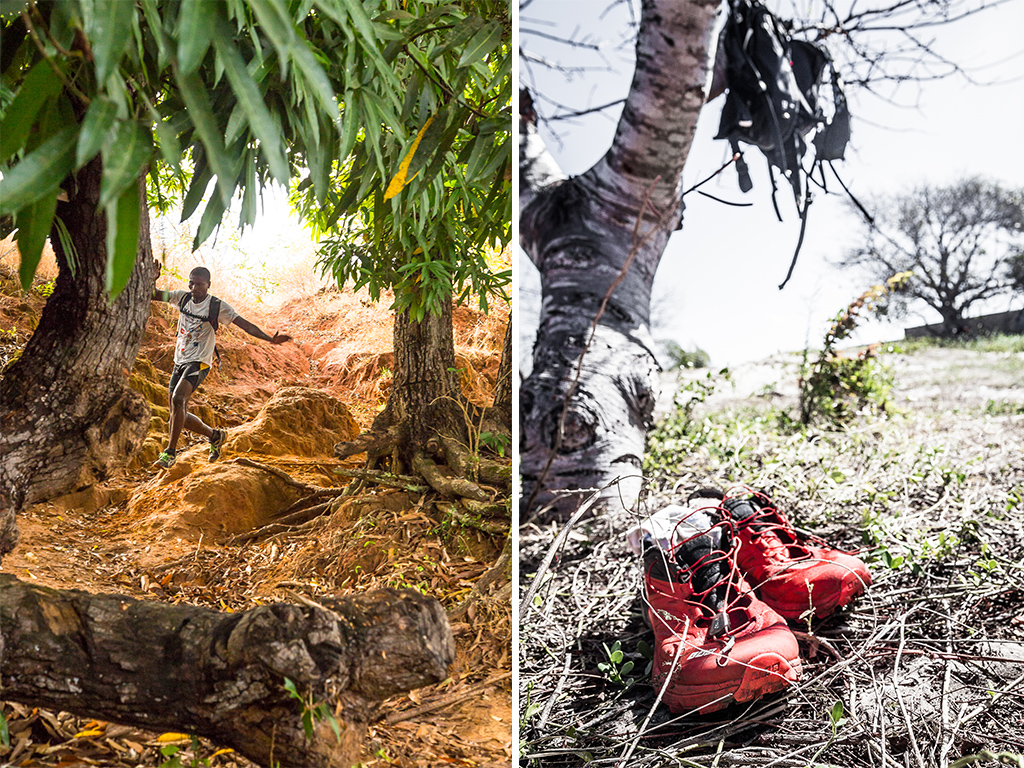
LEFT, Malagasy athlete Romuald Jaoriziki skips down a technical descent near Irodo River; RIGHT, Even Thabang’s shoes look fast.
The following day, after a two-hour flight above an island that melts from fertile highlands into gnarled brown folds and tropical scrub, I meet the other runners on the balcony of the hotel La Terrasse du Voyageurs in Antsiranana. Formerly Diego Suarez (prior to 1975), this bayside town was once coveted by the British who tried to muscle out Vichy French during World War II. Today it hums with New York-yellow tuk-tuks that weave between a Seuss-like farrago of wooden corner stores and pastel-coloured buildings no more than five or six storeys high. On side streets, loose items of laundry duel like Afghan kites and the smell of burnt rice, carbon and bargain fill the air. It is also a playground peninsula for tourists and, I’m told, a place where pasty old Italian men bring their retirement euros and rent hotel rooms for months and pretend to live like kings.
They forget that this is Africa – a continent that has learnt how to deal with that kind of scourge. Here, they’re swooned into buying houses and lavish gifts for local women who promise them the world and chase them home when they’re dry.
On the balcony of La Terrasse du Voyageurs I’m glad to discover that this is not just a race for the ultra fast or ultra fit. It is impossible to mention everyone, but among the not-so-elite foreigners is Luis Rene Menendez, a 72-year-old Argentinian who looks a little like the writer Jorge Luis Borges, just more cheerful. His partner Delores is not running. She spends the days visiting the national parks and highlights of the Diana region, returning each afternoon with gorgeous photos and a face less flushed than his.
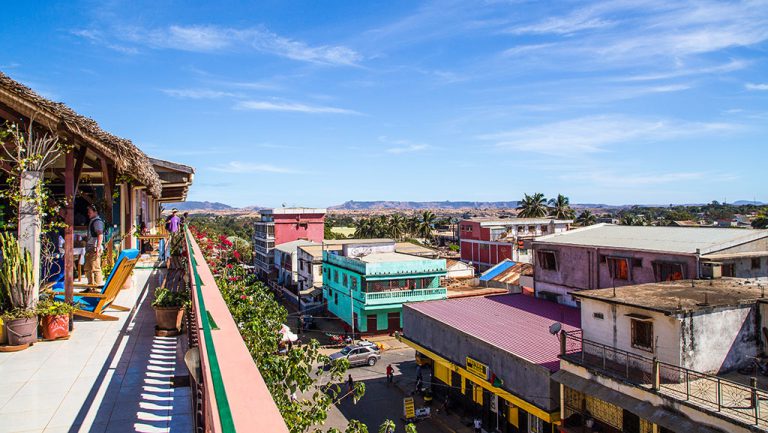
The view from the balcony of La Terrasse du Voyageurs in Antsiranana. From here it’s a short tuk-tuk ride (about R5) to the city centre, which hums at night.
There’s Marcus Fong (39), an IT technician from Macau who plans to run all six of the World Marathon Majors (Tokyo, London, Boston, Berlin, Chicago, New York). He’s taken leave for this event, but tells me that he’s had to buy a local sim card and airtime should there be any urgent IT queries at work. I tell him that I think ‘Have you tried turning it off and on again?’ would make for a great voicemail. He doesn’t laugh.
There’s Steven Paul Halton (35), an Englishman who has cycled the length of Africa and has a pair of calves that look like two watermelons strapped to hockey sticks. And Yannick Dinmamod, a 32-year-old Frenchman who sells auto parts in Antananarivo. And then there is Gavin Sacks (49), a compatriot from Johannesburg who saw an ad in Runner’s World magazine and who, when quizzed on why he joined, simply said: ‘Looked cool, somewhere new, I thought why not?’
Of the Malagasy contingent that makes up much of the field, many are very fast. There is Laurette Rasoarinomena (28), a runner from Toliara, Heritiana Andrianaivo (28) from Antananarivo and Revelinot Raherinandrasana (38), who has just one arm. He will, after the race, go on to place 10th in the men’s 1500m in the Paralympic Games in Rio, only the second Malagasy in history to compete in an Olympic final.
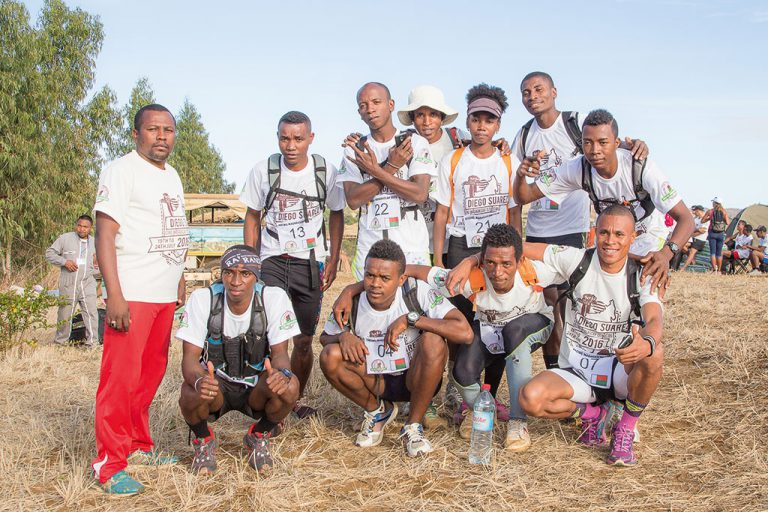
The local athletes – friendly and very, very fast.
And there is also Zephirin Zimazava (37) who is blind. He will run almost every stage with one arm on his friend and guide’s shoulder. Step by awkward step they will cross rivers, clamber over rocks and, fuelled by a stream of constant audio and physical communication, sail through fields. What I discover that night about this mishmash of humans, aside from a love of running and the bravery to sign up for something that’s never been done before, is that they all love the idea of being somewhere new.
And so here we are, somewhere new: a plateau above Beamolana Waterfall, a pinstripe of white water cascading into a small volcanic lake a few kilometres east of the village of Anivorano, a bumpy three-hour drive south of Antsiranana. It’s the first day of Racing Madagascar and the long grass glows golden in the early morning sunshine and the sky is big and full of promise. Beneath a red- and green-striped banner, 23 runners wait for the starter’s orders. Ahead of them, a barely distinguishable zebu (cattle) path of flattened grass, trampled into the dirt, winds its way towards the horizon. Nobody has run here before. The race begins.
Heritiana surges ahead, pausing only to morph into a Super Mario Brother at the first (of many) river crossings before hopping from stone to stone without breaking his stride. A string of seven Malagasy athletes, and Thabang, follow. I don’t see them again until the finish line, 20 kilometres later. And here I should probably tell you how I am getting around. I am aboard a Honda XT400, led by French-speaking guide François Serrano, camera gear and notepad in a waterproof bag strapped to my back. My plan is to buzz from checkpoint to checkpoint to photograph the runners for the first four days. Then, on day five, I will swap riding boots for running shoes and run the 28-kilometre stage with them.
It will be the furthest I’ve ever run in one go.
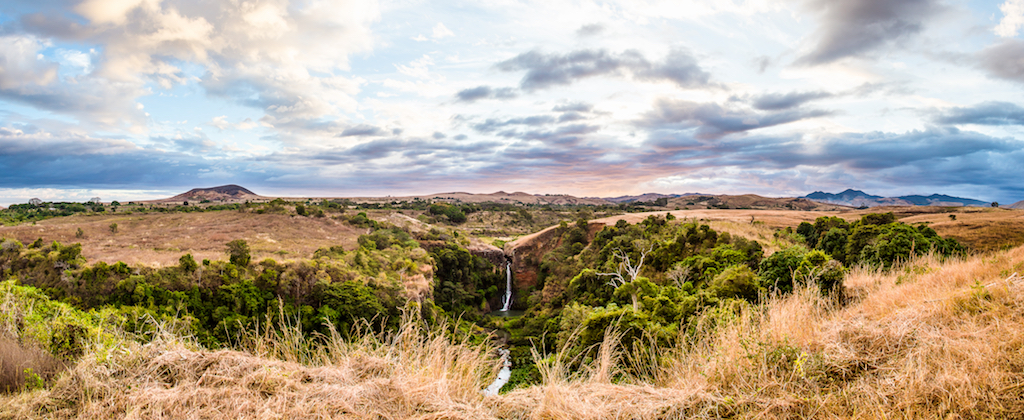
This was the view from the starting line of the inaugural Racing Madagascar trail race – above the Beamolana Waterfall in the Diana Region.
Day one takes Heritiana an hour and a half. Narcisse Zithaniel (19) finishes a close second and Thabang is third. Zephirin crosses the line with his guide three hours later. That afternoon some of us head into Anivorano to check out the market. We eat fresh fruit, drink warm Coca-Cola and watch bicycles crammed with baguettes weave between old Renault 4Ls while chickens dart for their lives. That evening, back at our campsite, I take stock of the operation. It takes two large Kosovos and a fleet of five 4x4s to transport the camp between each day’s finish line. There are canvas tents, bucket showers and pit loos walled by palm fronds and always positioned with the best views. There is a kitchen area, buzzing and simmering with activity, and two palm-bedecked wooden shelters with long benches beneath them, where we will eat. This is more than a mobile village, this is a military-scale operation.
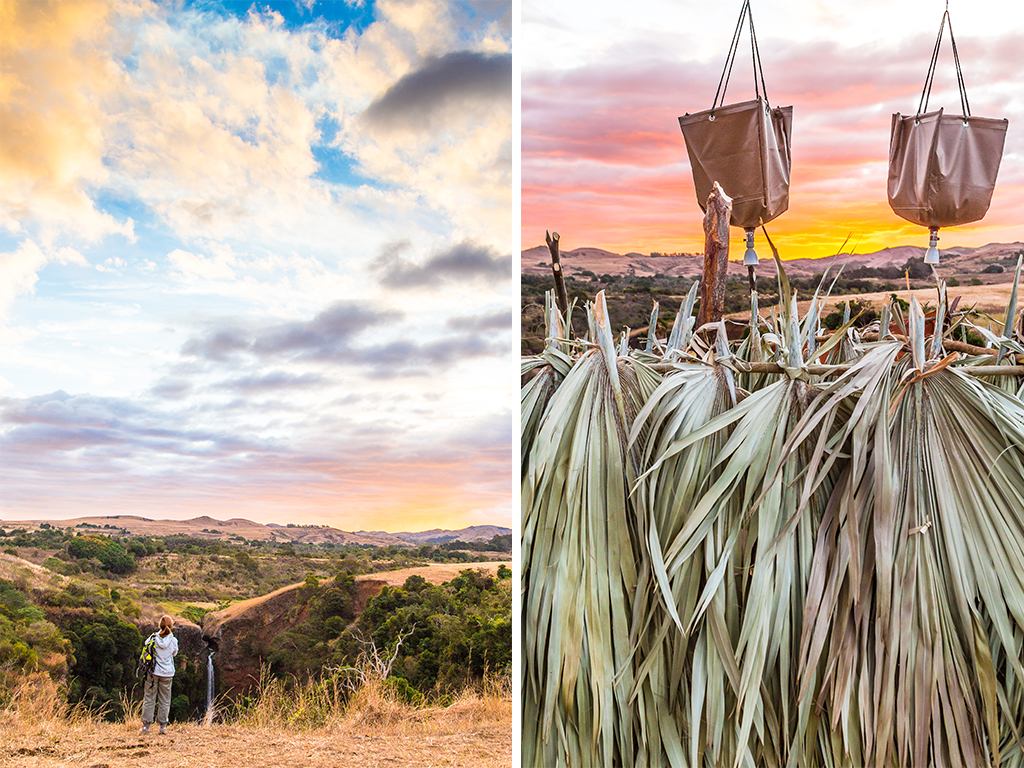
Pit loos and great views – this is what a self-sufficient stage race in one of the island’s most remote regions looks like. I call it bliss.
For the next three days, the route creeps slowly north-east and the stage winners chop and change between the locals. The pace is formidable but Thabang is always close… never more than a minute or two behind the winner. Mornings are bright and hot and the afternoons brighter, and hotter. On the second day, athletes around a volcanic lake brimming with crocodiles and pass herdsmen bellowing at their zebu herds. On the third, they cross the Irodo River, a torrent that splits two villages and feeds a green and brown chessboard of rice fields below.
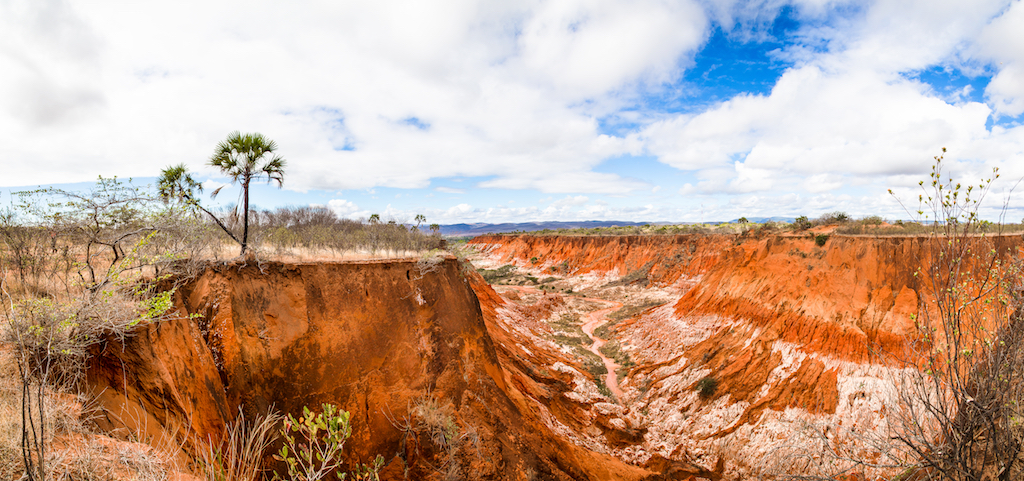
This laterite canyon, which forms the centrepiece of Tsingy Rouge national park, was created over centuries by erosion and chemical weathering.
The next day runners traverse large canyons of rust-red mineral spires that reach for the skies. One day it becomes so hot that a patch on François’ motorcycle tube delaminates, and I leave him to repair it as I chase down the leaders in the hope of getting a shot of them at the finish. On another, one of the Kosovos breaks down five kilometres from the finish line and staff walk the rest of the way for help. The days are unbelievably tough. But the nights are invigorating. There is good food and music, either country and western rattling out from a cellphone, or djembe drums and a guitar, played in turn by the locals and accompanied by Malagasy lyrics that float up at the ends like butterflies. Lunches are verlepde baguettes, baked by the sun. Dinners are rice, zebu skewers and fish. And there are coconuts, first sucked dry and then hacked in two for the flesh. One evening Gavin, Yannick and I wander into a nearby village in Ankerika and share a quart of THB (Three Horse Beer) and stand awkwardly in our tracksuits while a generator-powered DJ booth fuels an open-air party.
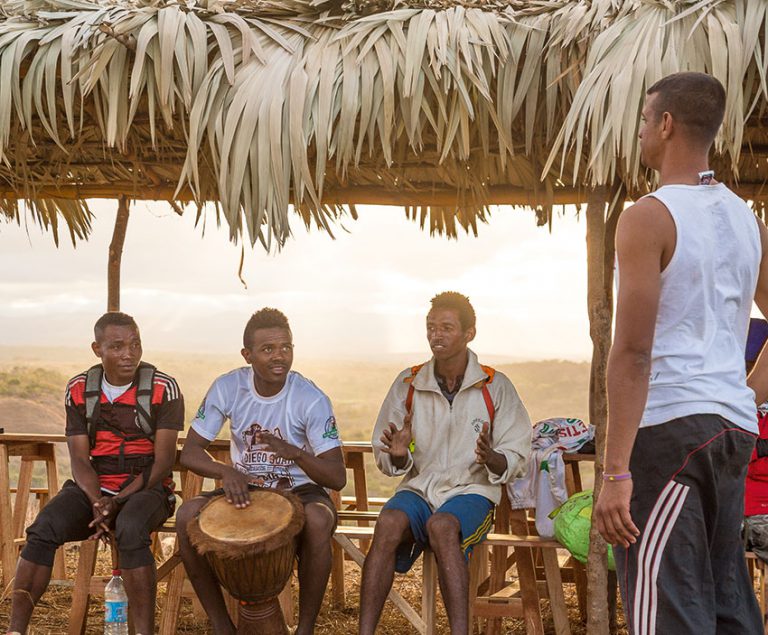
Making music with Morisse Morisse, Housseny Nasser and Herve Djaonoro.
On the fourth night Yannick tells me that there are two kinds of chickens in Madagascar. Akoho gasy is the kind you’ll find in most markets – lean and spry from spending its days dodging rickshaws and eating whole grains wherever it can find them. And then there is the Occidental kind. It spends most of its time indoors; its food comes in packaging, concocted so as to expand its waistline without much thought for its bloodline. It gets a little exercise here and there and if prodded will wobble and cluck, but get running eventually. And then it’s the fifth day and I am the second chicken. I am not unfit but I’ve always needed some goading to get my running shoes on, and my diet is more bacon than a banana. But I have trained, somewhat, for this day and afoot, with a hydration pack filled with nuts and an extra pair of socks, I quickly find a good stride. Too good.
For the first 12 kilometres I settle in behind Marcus at a pace that’s well beyond my means. In his wake I sink into the sand on Ampondrafeta Beach, tiptoe over muddy channels and cruise along a Jeep track to the first checkpoint. There, exhausted, I tell Marcus in a scene that resembles a bad action movie to ‘Go on without me!’ And so he does, and I don’t see him again until camp that afternoon.
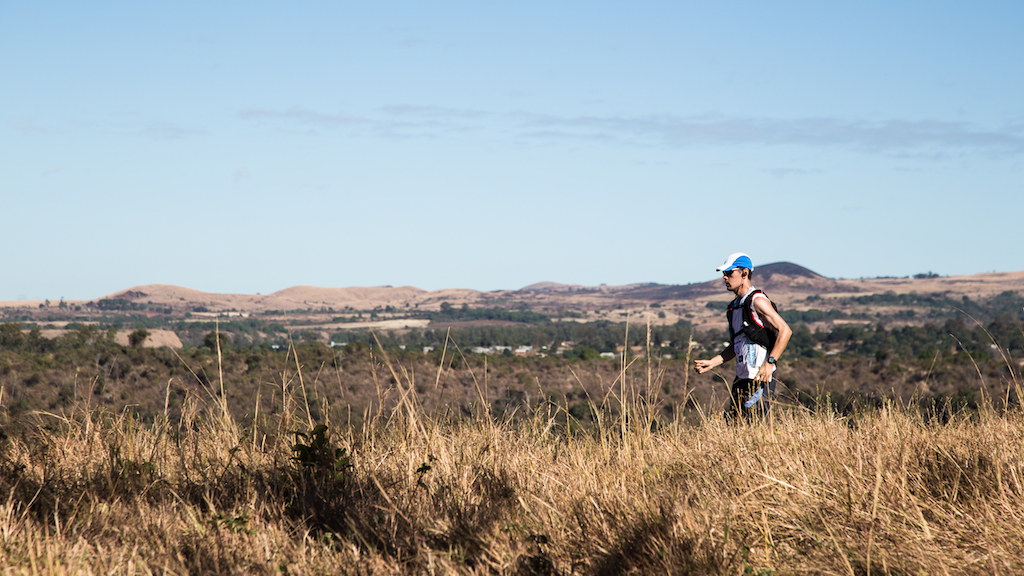
Marcus Fong travelled the furthest to be at the race. He lives in Macau, had great pace and a seemingly endless supply of freeze-dried snacks in his bag. He was my running mate for half of the 28-km stage on Day 4 that I ran. Then he buggered off leaving me to run the rest shouting in agony at the empty heavens.
To tell you about the next 16 kilometres is to tell you what any runner will tell you about running. It was the full gamut of emotions. After the pain and self-doubt comes reasoning (just eight more kays to the next checkpoint, you’re basically halfway), bargaining (one more kilometre and you can have a break) and then bullying (come on, you little wimp! People fought wars in army boots and ran further).
But there were other moments too. Moments that some will tell you are the most exhilarating you’ll feel as a human being inside its own body. Moments when pleasure and suffering become one and the distinctions between yourself and the world blur. The long hours on the road, early mornings and nights out missed with friends pay off and you’re cruising, a missile above a set of limbs like two pistons extending and returning in time with your breath, propelling you forward. That hardly ever happened. What mostly happened was the inability to think at all.
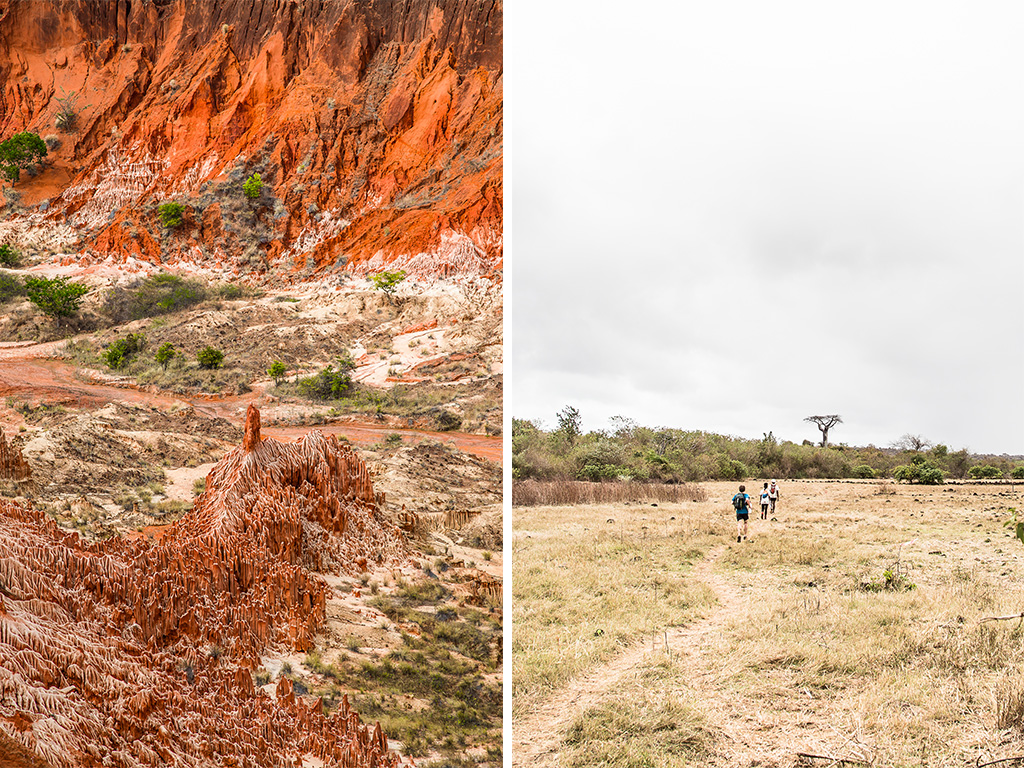
Each day presented runners with new terrain: from red canyons to secluded beaches and even a baobab forest (not that common in northern Madagascar, I discovered).
In What I Talk About When I Talk About Running, the author Haruki Murakami talks about running in a void. On cold days, he writes, ‘I guess I think about how cold it is … and about the heat on hot days.’ But for the most part, when asked what he thinks about, he says, ‘I don’t have a clue.’ I think many people run in order to find this void. For some, like me, I’m certain that state is achieved by your mind simply blacking out due to overwhelming suffering. For others, it’s probably more esoteric. Regardless, I ran much of that day almost entirely oblivious of my surroundings. It did not matter whether I was here, in a remote region of Madagascar, or in New York pounding the same square block of pavement. Inside the void was just myself, the sound of my breath and my shoes on the earth.
Perhaps I got too much sun, but that day the lunacy of long-distance athletes such as Ashprihanal Aalto made sense. The difference is that here, on this island, it’s more than just running. It’s also about the moments gleaned in recovery beneath dried palm fronds, learning a foreign language and laughing like friends while music plays and the light fades behind an emerald bay and there’s nobody but you and your new comrades around.
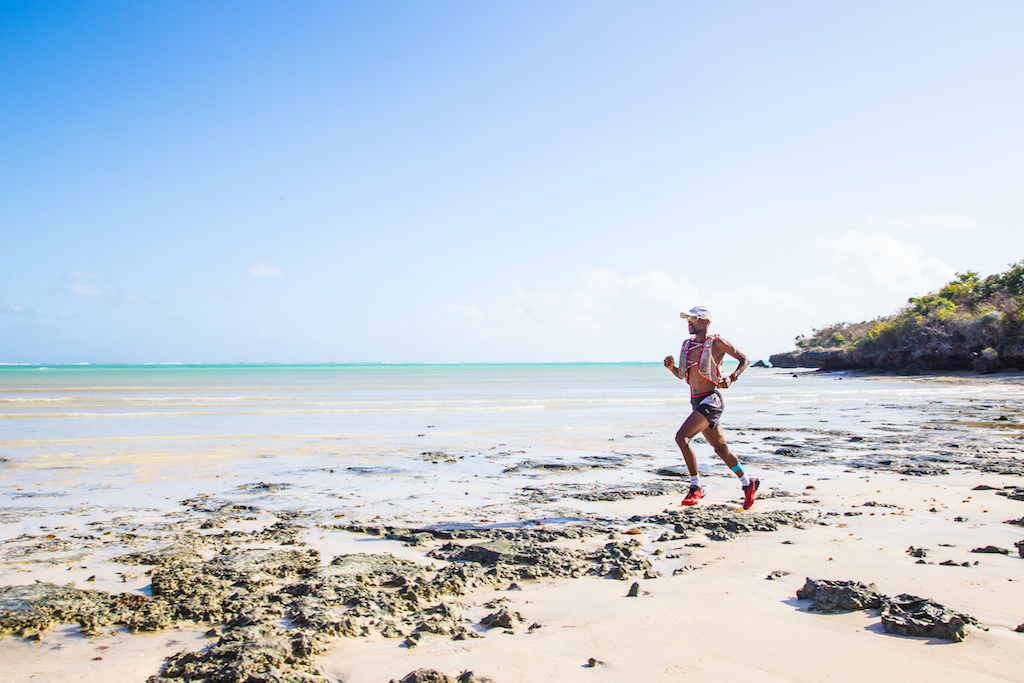
Thabang Madiba, one of South Africa’s top trail runners, rounds a secluded bay on the second-to-last day. He didn’t have it all it his own way against the locals.
Thabang crosses the finish line first that day: a red and green banner pegged into the sand on a quiet beach with kite surfers blazing towards the sun in the background and a lone timekeeper with a clipboard clocking him in. He has won the race, his race craft prevailing over the sheer bloody-mindedness of the Malagasy athletes. The next day, a seven-kilometre dash past Pain de Sucre into Antsiranana is a formality, the last stretch accompanied by wheelchair athletes to whom proceeds from this event go. That evening Thabang raises a silver totem, the trophy, as the winner of the inaugural Racing Madagascar. Laurette wins the women’s trophy and Gavin, to his surprise, picks up an award for the first veteran, just beating out Luis with an overall time of 23 hours and 26 minutes. Twelve hours behind Thabang.
‘I guess it pays to be a part of an inaugural event,’ Gavin jokes, ‘even I get a prize.’ But it’s not like he just turned up. He, like everyone else, trained for this. And if the psychologists are to be believed when they say a significant part of the enjoyment of travel is the part where you prepare for it, then for Gavin, the experience begins long before the plane touches down. And sometimes at the end of it is a place so exciting and beautiful, and challenging. A place that’s worth getting outside and pounding your own bit of pavement for, wherever in the world that is.
Plan Your Trip
Getting there
I flew return with SA Airlink from Johannesburg to Antananarivo. Flights are from R9500. From there, Air Madagascar flies to Antsiranana from R3500 return. There are just five aircraft that service the island so delays and cancellations are frequent. Allow yourself enough time between connections. In fact, give yourself a buffer day on each side of your trip, just to be safe. There are also direct flights from Johannesburg to Nosy Be, further north, with Airlink. From R13500 return. flyairlink.com, airmadagascar.com
Need to know
South Africans can get a visa on arrival. It costs R380. There are working ATMs in some major centres but card facilities are rare. It’s best to carry ariary, the local currency. Change your rands into euro before you fly and then convert that into ariary on arrival. The climate is tropical but malaria is rare.
Racing Madagascar
The next edition of Racing Madagascar takes place from 11 – 16 July 2017. The entrance fee is R23000 per runner and covers all accommodation, meals and transport from Antsiranana to and from the finish line. It does not cover flights. Participants are required to bring all their own gear and necessary extra nutrition. It’s a semi self-sufficient race and while your bags are transported and sustenance is provided at the checkpoints, you are on your own for most of the race. It may not just be for the ultra fast and ultra fit but you do need to train and be in good health. It’s still 150 kilometres over six days, you know. racing-madagascar.com
Supporters package
The unique aspect of this race is that there is a full travel itinerary for supporters. Each day is spent with a guide, exploring the highlights of the region before meeting up with the runners every afternoon. It’s a great option for those who want to bring their families, partners or friends. It costs from R17500 per person and includes all meals, accommodation, transfers to and from camps in a 4×4, guides and entrance fees to the national parks. boogieevents-madagascar.com
Do this
(All prices below are included in the supporters package).
Explore Tsingy Rouge Park, an incredible rust-red canyon carved out by the Irodo River. The rock formations look like stalagmites, shaped by wind and water. It is not a national park so there is no entrance fee but a guide is required and costs from R180 per day. evasionsansfrontiere.com
Eat Akoho Gasy (chicken) in Anivorano. There’s a market every Tuesday from 8am until 1pm (though it goes on until much later). From R15 a piece.
Visit Amber Mountain National Park. It’s home to the leaf chameleon (Brookesia tubercular), the smallest in the world. The park is only accessible on foot and there is a range of walks from five to 15 kilometres that wind their way past volcanic lakes and sacred waterfalls. Park entrance is R300 per person and there is a mandatory guide fee of R180 per day. parcs-madagascar.com
Climb French Mountain, a strategic military position during World War II. It’s a fairly strenuous three-hour loop but the views over the bay are spectacular. There is no entrance fee but it’s mandatory to go with a guide. From R180 for the entire hike. evasionsansfrontiere.com
Stay here
La Terrasse des Voyageurs was the accommodation for the first and last night of the race. Rooms are neat but it’s what I like to call an ‘either or’ hotel. I either had hot water or electricity, but never both. From R200 for two and from R50 per person for breakfast. terrasseduvoyageur-hotel.com

Rice is the island’s staple food. Grown in striking green waterlogged fields, it was introduced by Indonesian and Malaysian settlers more than 1 000 years ago.










